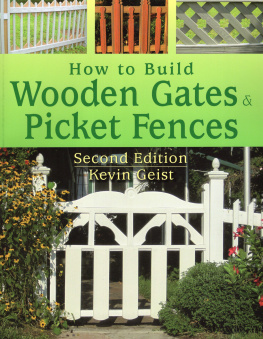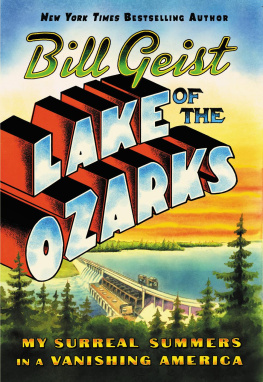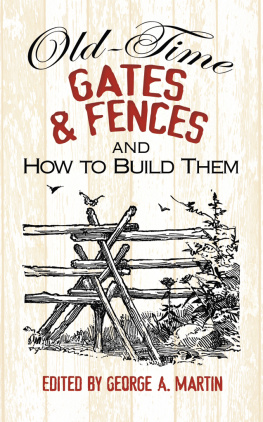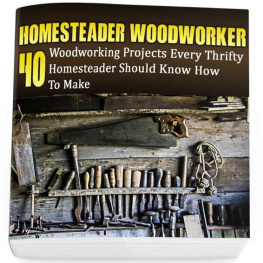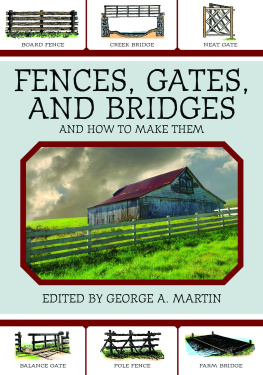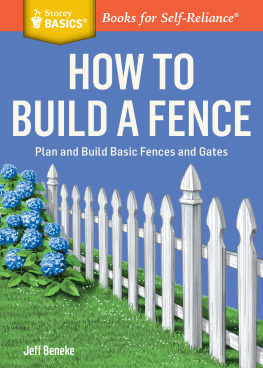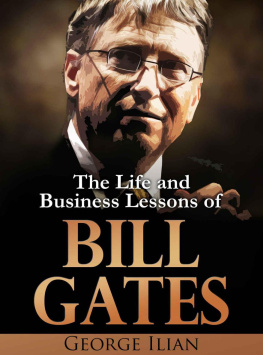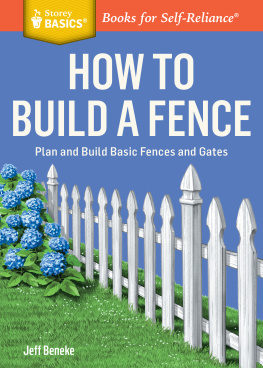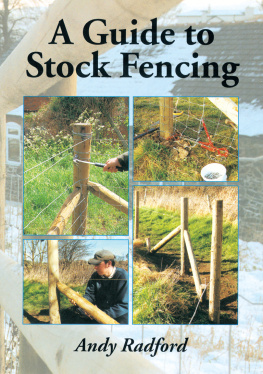Geist - How to build wooden gates and picket fences
Here you can read online Geist - How to build wooden gates and picket fences full text of the book (entire story) in english for free. Download pdf and epub, get meaning, cover and reviews about this ebook. City: Mechanicsburg;Pa, year: 2011, publisher: Stackpole Books, genre: Home and family. Description of the work, (preface) as well as reviews are available. Best literature library LitArk.com created for fans of good reading and offers a wide selection of genres:
Romance novel
Science fiction
Adventure
Detective
Science
History
Home and family
Prose
Art
Politics
Computer
Non-fiction
Religion
Business
Children
Humor
Choose a favorite category and find really read worthwhile books. Enjoy immersion in the world of imagination, feel the emotions of the characters or learn something new for yourself, make an fascinating discovery.
- Book:How to build wooden gates and picket fences
- Author:
- Publisher:Stackpole Books
- Genre:
- Year:2011
- City:Mechanicsburg;Pa
- Rating:5 / 5
- Favourites:Add to favourites
- Your mark:
- 100
- 1
- 2
- 3
- 4
- 5
How to build wooden gates and picket fences: summary, description and annotation
We offer to read an annotation, description, summary or preface (depends on what the author of the book "How to build wooden gates and picket fences" wrote himself). If you haven't found the necessary information about the book — write in the comments, we will try to find it.
Geist: author's other books
Who wrote How to build wooden gates and picket fences? Find out the surname, the name of the author of the book and a list of all author's works by series.
How to build wooden gates and picket fences — read online for free the complete book (whole text) full work
Below is the text of the book, divided by pages. System saving the place of the last page read, allows you to conveniently read the book "How to build wooden gates and picket fences" online for free, without having to search again every time where you left off. Put a bookmark, and you can go to the page where you finished reading at any time.
Font size:
Interval:
Bookmark:
Sources
BJM Industries
12478 U.S. Route 422
Kittanning, PA 16201
(800) 683-3810
www.bjmindustries.com
Product: Millennium Plastic Lumber
Eco-Tech
6455 S. Pine Street
Burlington, WI 53105
(262) 539-3811
www.eco-tech.ws
Products: Eco-Tech Plastic Lumber,
Dura Max Structural Lumber
Fence America
198 Random Drive
New London, NC 28127
(800) 215-2740
woodshadesfencing.com
Product: WoodShades Composite Fencing
Fiberon
181 Random Drive
New London, NC 28127
(800) 573-8841
www.fiberondecking.com/products/fencing
Product: Fiberon Fencing
Grizzly Industrial
1821 Valencia St.
Bellingham, WA 98229
(800) 523-4777
www.grizzly.com
Products: Grizzly Tools
A Beautiful, Functional Fence
C ompared with other home construction projects, creating a fence may be less complex than putting on an addition or building a garage, but it does require planning, design, and an under-standing of structural concepts. If you want a fence that lasts a lifetime, you need to build it with quality materials and attach it to a sturdy foundation. When maintenance is required you will want to make it easy to replace damaged parts. Yes, you can put a pointed top on a bunch of boards and make a perfectly acceptable, ordinary picket fence, but there are multitudes of beautiful designs to choose from and there is nothing preventing the artist in you from making your own designs.
Fences made society. From the time the first agrarians staked off a piece of land to keep marauding fauna from pillaging the crops, civilization was born. People set physical boundaries on property that defined ownership and limited access.

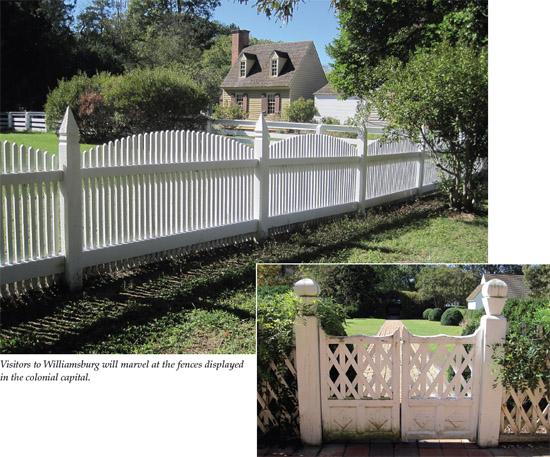
Throughout the Colonial Era and early Federal Period of America, fences remained largely practical structures with little ornamental value. Those early Virginia forts were not grand stone edifices, but really just palisades, a large burly version of a picket fence, albeit crude in appearance. Only the wealthy minority had grand and ornate fences around their estates and houses, but most common folks had very crude, simple, and utilitarian fences for the purposes of managing livestock and dividing property.
Managing livestock was the primary purpose for urban fencing. In the days before dairy products were trucked from distant farms, it was necessary for the cows and goats to be close at hand for fresh milk. Even in town, many people owned livestock to supply milk, eggs, and butter for daily meals. Livestock can do a great deal of damage if permitted to wander where they will. In the eighteenth century, Williamsburg had many laws regarding the height, construction, and appearance of fences. It was required of newcomers to construct fences within six months of building their houses.
Today, visitors to Colonial Williamsburg marvel at those fences, yet it would be a mistake to think that the whole of the Virginia colony enjoyed and displayed such charming designs. Finely crafted fences were not for the typical farmer, and few had the money and status to afford the beautifully cut posts and ornately turned urns and finials that we like to envision when we think of colonial architecture.
From the birth of the nation to the middle of the 1800s, the countryside was dotted with log cabins and only the occasional Georgian, Federal, or Greek Revival mansion. Cruder forms of fencing like split rail and stockade remained common through the middle of the nineteenth century. Then a young landscape architect named Andrew Jackson Downing came upon the stage. He had a vision for transforming the countryside with beautiful Italian-style villas for the wealthy and charming cottages for the less affluent. He was not a big fan of the bulky primitive fences commonly seen in his day. For both homes and fences, he frequently advocated using earth tones to minimize the visual impact of human alterations to the landscape and to blend architecture with its surroundings. Downings writings laid the groundwork to help establish Italianate and Carpenter Gothic architecture. With those styles came the opportunity for newer, more modern fence designs.
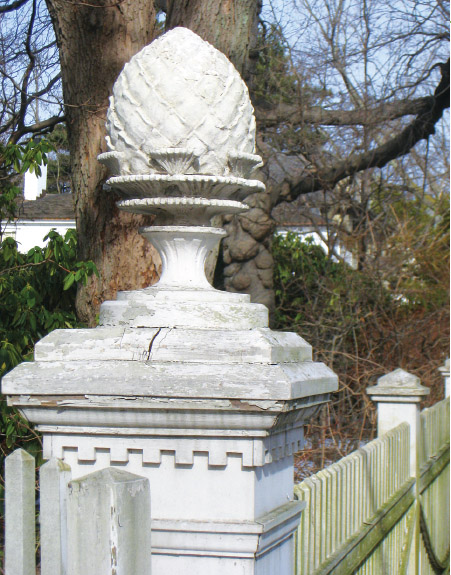
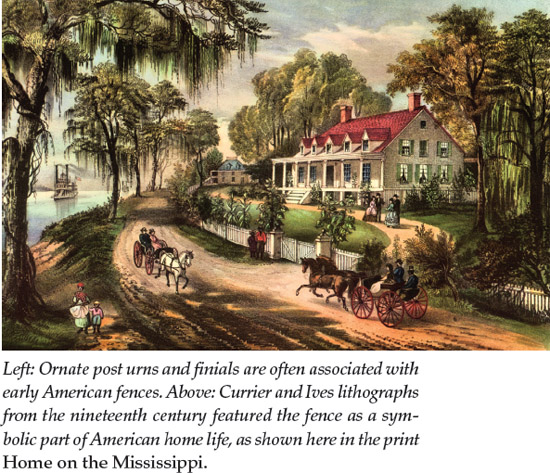
Fences were still everywhere in the mid-nineteenth century. Livestock was still taken to market by herding through the streets, and fences in the front yards kept any stray animals off porches and out of gardens. Fences were accepted, even embraced, by the population as part of that American landscape. Currier and Ives lithographs of the period frequently included fences. Their famous American Homestead series had a collection of prints depicting each season. The prints showed four different American homes, each one with its own fence.
A contemporary of Downing was architect Samuel Sloan of Philadelphia. He also designed villas for the wealthy and cottages for the common people. Sloan recognized the essential place of fencing in American life. He decided to design fencing that would complement the current architectural modes. While Sloan used wrought- and cast-iron patterns in his works for wealthy clients, he was aware that the cost of those materials was prohibitive for the growing middle class. In the mid-1800s, both lumber and labor were cheap. In his 1852 home designs book, Sloan included patterns for wooden fencing that complemented the cottages that were affordable to the average middle-class citizen. He set a precedent that would be followed by many architects and designers. From that point on, house plan books frequently featured patterns for picket fences and gates.
Sloans designs, although not as ornate as some to come in the next decade, still required curved exterior and round interior cuts. In 1852, most of these designs would have been cut by hand. It is incredible to think of the amount of time and energy that property owners invested in their buildings and structures.
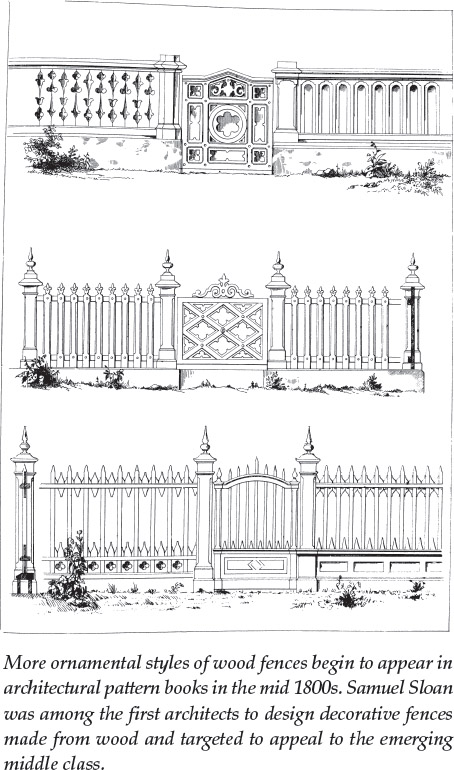
Calvert Vaux, Marcus F. Cummings, and Charles C. Miller followed Sloan with publications for home plans that included decorative fences designed to complement the architecture of their houses. The fence styles were becoming even more ornate, with intricate cuts throughout the bodies of the pickets. Beautifully cut and painted pickets became more and more common, and not just in the garden. Houses themselves were clad with pickets. The fence picket became siding and trim, commonly hung upside down in gable ends and on the edges of the roof eaves.
Further ornamentation came to the fence with decorative layers of wood, or appliqus, being used to adorn pickets and other types of grid infill. Inlays also became popular. Previously, it was not uncommon to ornament posts and gates with appliqus and inlays, but individual pickets now began to enjoy this lavish treatment on a more regular basis.
Up until the Civil War, these ornate pickets and fence components were cut using hand tools only, but automated tools were becoming available to make the task easier and faster. The band saw is a tool ideally suited for efficiently cutting curves in wood. The first known band saw design was patented in 1808. Although the mechanics of the saw itself were largely worked out, the science of making strong yet flexible blades for it was not. While America was embroiled in Civil War, blade science was progressing thanks to some persistent French inventors. The band saw became widely used in Europe. By the 1870s, band saws were being used more and more in woodshops throughout America. The new mechanical technology combined with cheap labor and an abundance of lumber lead to easier production. Wood ornamentation for home and garden structures flourished like never before in history.
Next pageFont size:
Interval:
Bookmark:
Similar books «How to build wooden gates and picket fences»
Look at similar books to How to build wooden gates and picket fences. We have selected literature similar in name and meaning in the hope of providing readers with more options to find new, interesting, not yet read works.
Discussion, reviews of the book How to build wooden gates and picket fences and just readers' own opinions. Leave your comments, write what you think about the work, its meaning or the main characters. Specify what exactly you liked and what you didn't like, and why you think so.

